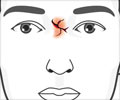Armored dinosaurs utilized their long, winding nasal passages to modify the temperature of the air they breathed and used them as heat transfer devices, says a new study.

Paleontologist Jason Bourke found that the convoluted passageways would have given the inhaled air more time and more surface area to warm up to body temperature by drawing heat away from nearby blood vessels. As a result, the blood would be cooled, and shunted to the brain to keep its temperature stable.
Modern mammals and birds use scroll-shaped bones called conchae or turbinates to warm inhaled air. But ankylosaurs seem to have accomplished the same result with a completely different anatomical construction.
Like human's noses, ankylosaur noses likely served more than one function. Even as it was conditioning the air it breathed, the convoluted passageways may have added resonance to the low-pitched sounds the animal uttered, allowing it to be heard over greater distances.
Source-ANI








